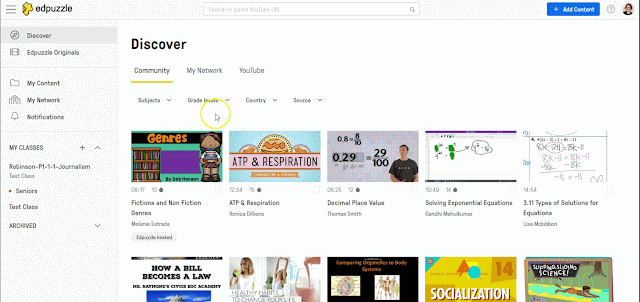Like most teachers at the start of the pandemic, Jack Forbis and Jennifer Haden, the band directors at Gene Pike Middle School, found themselves wondering how they were going to engage students remotely and transition their skills-based content to an online environment. When teaching over Zoom, according to Haden, they quickly ran into several unexpected hurdles including a lag time that wouldn’t allow the whole group to play together effectively, and unreliable sound where “kids would play and there was no sound coming back, so the only way to tell if they were playing right was by watching their faces and fingers.” Desperate for better ways to engage their learners, Forbis and Haden scoured posts made by other band directors in online forums and on social media. Eventually they came across a post touting the benefits of EdPuzzle, which allows teachers to add questions throughout videos to gauge student learning. They decided to dive in, recording videos that covered everything from an introduction to the staff and how to read music, to videos fully differentiated for each instrument demonstrating finger positions for notes and what they should sound like when played. They then uploaded these videos to EdPuzzle where they added questions to aid and reinforce student understanding.
When the district transitioned back to in-person learning, Forbis and Haden decided to continue incorporating EdPuzzle videos in their curriculum, finding innumerable benefits including differentiated instruction, increased student accountability, and greater consistency in the way that content is delivered. As Haden explains, “they’re getting the same content delivered the same way every time without us having to repeat it five times every period … and if a student misses class or there’s a substitute, those students are going to get the same level of instruction as everyone else.”
Recording and uploading EdPuzzles has not only allowed the band directors to differentiate instruction by instrument group, it has also allowed them to accommodate the diverse needs of their learners. Forbis points out that not every student has the same access to transportation for before and after school tutorials, and these EdPuzzles are “like an extra tutorial the kids can have at home.” If students are struggling with a particular skill and need additional support, they can pause, rewind, and rewatch the EdPuzzle as many times as they need to since, Forbis says, “the first part of learning is often modeling and mimicking, and that’s what this allowed us to do.” Before EdPuzzle, Forbis and Haden would go over the lesson in class and students would practice together, but at home they were practicing on their own. This meant, explains Haden, that “even if they were diligently practicing, if they were diligently practicing wrong, it wasn’t helping them.” The EdPuzzles give students something they can go back to and practice with over and over. Eduardo, a 6th grade clarinet player, finds value in this because he can rewatch the video at home before he records an assignment “and then try to match the same as Miss Haden.”
This ability to watch and rewatch is a key component in what Forbis and Haden say is perhaps the biggest benefit of using EdPuzzle in band -- increased student accountability. They can easily see whether or not a student has accessed a video, their current progress, and how long they interacted with the content. It’s also helpful for parents who often want to provide support by reinforcing practice at home, but, points out Haden, if they’re not familiar with the content “it can just sound like their kid is making sound at the house.” The EdPuzzles help parents see exactly what Forbis and Haden are asking their students to do. This has been further underscored by the move to Canvas, where Forbis and Haden embed the EdPuzzles directly in the instructions for their Media Recording assignments where students record and upload videos of themselves playing. With Observer access, parents can see the expectations set in the EdPuzzle and compare them with the video their student has submitted. This provides a clear picture of how well their student is performing, in terms of grades as well as ability.
While the benefits of transitioning to guided practice through EdPuzzle have been myriad, Forbis and Haden are the first to admit it took a lot of time and effort to set up. When asked what advice they’d have for teachers considering bringing in new tools, Forbis and Haden recommend adding things in a little at a time to give teacher and students time to adjust, and to keep in mind that while it may feel like a lot of work up front, it pays off when that content is ready to go the next year. The band directors are embodying this philosophy themselves, growing their EdPuzzle libraries as needed while also exploring new ways to boost student engagement and learning. This year they’ve incorporated Ningenius to transform learning notes and finger positions into a game, building a reward system where students compete to earn belts that earn them access to parties and other fun activities. Kelcie, another 6th grade clarinetist, appreciates how her teachers make learning and reviewing information fun using exciting online tools, adding that “people really want to get those belts!”
To get started with EdPuzzle in your own classroom, go to edpuzzle.com!
Pro Tip: Sharing content with another teacher on your campus? Bookmark their content page so you can find all of their videos easily!
My Network → Select School → Select Teacher → Bookmark in your browser!


.png)

.png)
.png)

No comments:
Post a Comment
Note: Only a member of this blog may post a comment.